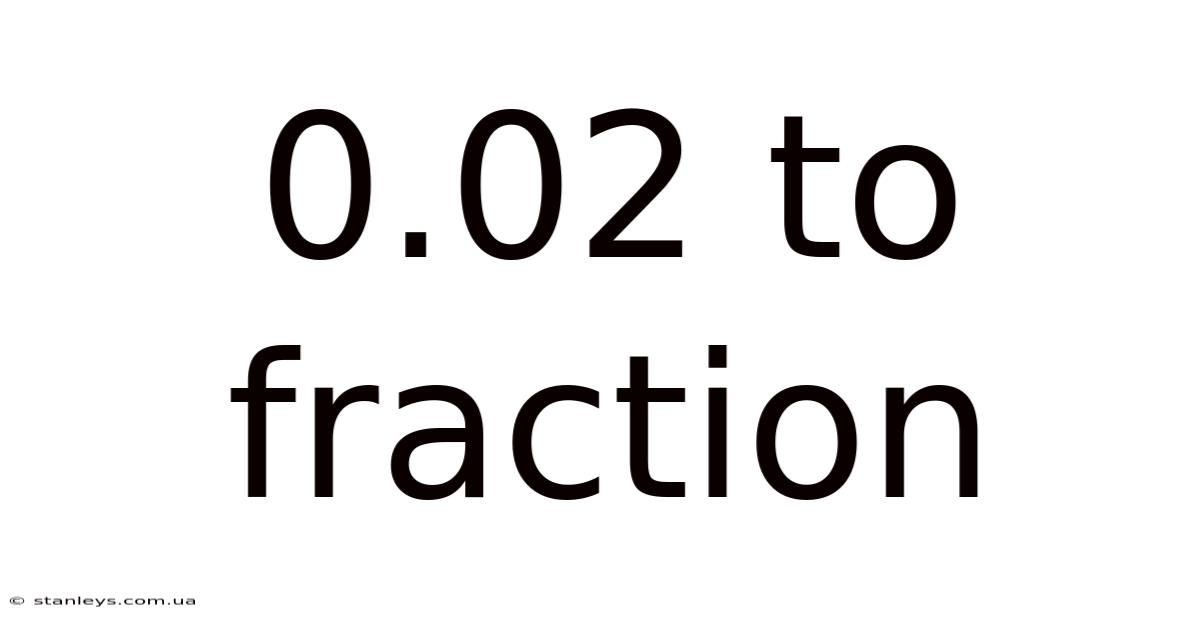0.02 To Fraction
stanleys
Sep 16, 2025 · 4 min read

Table of Contents
Converting 0.02 to a Fraction: A Comprehensive Guide
Understanding how to convert decimals to fractions is a fundamental skill in mathematics, crucial for various applications from basic arithmetic to advanced calculus. This comprehensive guide will walk you through the process of converting the decimal 0.02 into its fractional equivalent, explaining the underlying principles and providing helpful tips for similar conversions. We'll delve into the mechanics, explore the reasoning behind each step, and address common questions, ensuring you grasp the concept thoroughly.
Understanding Decimals and Fractions
Before we begin the conversion, let's briefly review the concepts of decimals and fractions. A decimal is a way of expressing a number using base ten, where the position of each digit relative to the decimal point determines its value. For example, in 0.02, the '2' is in the hundredths place, meaning its value is 2/100.
A fraction, on the other hand, represents a part of a whole. It consists of a numerator (the top number) and a denominator (the bottom number). The numerator indicates how many parts you have, and the denominator indicates how many equal parts the whole is divided into.
Converting 0.02 to a Fraction: Step-by-Step
Converting 0.02 to a fraction involves understanding the place value of the digits. Here's the step-by-step process:
Step 1: Identify the Place Value
The decimal 0.02 has the digit '2' in the hundredths place. This means it represents two hundredths.
Step 2: Write the Fraction
Based on Step 1, we can directly write the fraction as 2/100. The numerator is 2 (the digit in the hundredths place), and the denominator is 100 (representing hundredths).
Step 3: Simplify the Fraction
The fraction 2/100 can be simplified by finding the greatest common divisor (GCD) of the numerator and denominator. The GCD of 2 and 100 is 2. We divide both the numerator and denominator by 2:
2 ÷ 2 = 1 100 ÷ 2 = 50
This simplifies the fraction to 1/50.
Therefore, 0.02 is equivalent to the fraction 1/50.
The Underlying Mathematical Principles
The conversion process relies on the fundamental relationship between decimals and fractions. Decimals are essentially fractions with denominators that are powers of 10 (10, 100, 1000, etc.). The number of digits after the decimal point determines the power of 10 used in the denominator.
- For example:
- 0.2 = 2/10
- 0.02 = 2/100
- 0.002 = 2/1000
Simplifying the fraction involves reducing it to its lowest terms by dividing both the numerator and the denominator by their greatest common divisor. This ensures the fraction is expressed in its simplest form.
More Complex Decimal to Fraction Conversions
The method outlined above can be applied to convert any decimal to a fraction. Let's consider a few more examples:
Example 1: Converting 0.375 to a fraction
- Identify the place value: The last digit, 5, is in the thousandths place.
- Write the fraction: 375/1000
- Simplify the fraction: The GCD of 375 and 1000 is 125. Dividing both by 125, we get 3/8.
Therefore, 0.375 = 3/8
Example 2: Converting 0.12 to a fraction
- Identify the place value: The last digit, 2, is in the hundredths place.
- Write the fraction: 12/100
- Simplify the fraction: The GCD of 12 and 100 is 4. Dividing both by 4, we get 3/25.
Therefore, 0.12 = 3/25
Example 3: Converting a recurring decimal to a fraction
Recurring decimals (decimals with repeating digits) require a slightly different approach. Let's take 0.333... (0.3 recurring) as an example:
- Let x = 0.333...
- Multiply by 10: 10x = 3.333...
- Subtract the first equation from the second: 10x - x = 3.333... - 0.333... This simplifies to 9x = 3.
- Solve for x: x = 3/9 = 1/3
Therefore, 0.333... = 1/3
This method of solving for x is commonly used to convert repeating decimals to fractions.
Frequently Asked Questions (FAQ)
Q1: What if the decimal has a whole number part?
A: If you have a decimal with a whole number part (e.g., 2.02), convert the decimal part to a fraction as described above, then add the whole number. For 2.02, the fractional part (0.02) is 1/50. So, 2.02 = 2 + 1/50 = 101/50.
Q2: Why is simplifying the fraction important?
A: Simplifying a fraction reduces it to its simplest form, making it easier to understand and work with. It also ensures consistency in mathematical calculations.
Q3: Can I use a calculator to help with this process?
A: Many calculators have a function to convert decimals to fractions. However, understanding the manual method is crucial for building a solid mathematical foundation.
Conclusion
Converting decimals to fractions is a vital skill in mathematics. The process involves identifying the place value of the decimal, writing it as a fraction, and then simplifying the fraction to its lowest terms. This guide provided a detailed explanation of the process, including examples and addressing common questions. Mastering this skill will enhance your understanding of numbers and their various representations, making you more confident in tackling a wider range of mathematical problems. Remember to practice regularly to solidify your understanding and build fluency. By understanding the underlying principles, you'll be able to convert any decimal to its equivalent fraction with ease and confidence.
Latest Posts
Related Post
Thank you for visiting our website which covers about 0.02 To Fraction . We hope the information provided has been useful to you. Feel free to contact us if you have any questions or need further assistance. See you next time and don't miss to bookmark.